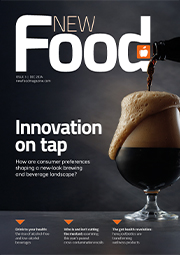Falling back in love with seafood
- Like
- Digg
- Del
- Tumblr
- VKontakte
- Buffer
- Love This
- Odnoklassniki
- Meneame
- Blogger
- Amazon
- Yahoo Mail
- Gmail
- AOL
- Newsvine
- HackerNews
- Evernote
- MySpace
- Mail.ru
- Viadeo
- Line
- Comments
- Yummly
- SMS
- Viber
- Telegram
- Subscribe
- Skype
- Facebook Messenger
- Kakao
- LiveJournal
- Yammer
- Edgar
- Fintel
- Mix
- Instapaper
- Copy Link
Posted: 21 November 2018 | Richard Watson | No comments yet
Richard Watson of Seafish assesses the current picture in terms of how seafood is performing in the retail market, what consumers are looking for and how more variety could turn fortunes around.


As an island, the UK is surrounded by a bounty of wonderful seafood, which we recently celebrated as part of Seafood Week 2018. We have a rich history in fishing and our national dish is fish and chips. Not to mention that Government health guidelines recommend we should all be eating two portions of fish a week – one being oily – as part of a balanced diet. However, for the last 10 years seafood has experienced a sustained period of inflation and price driven growth, resulting in falling consumption (Figure 1).
With building pressure from economic and political uncertainty, along with the continued rising inflation and reduced spending power of consumers, it looks like a trend that could be set to continue (highlighted in the Seafood in Multiple Retail 2018 report by Seafish, published in September 2018).
Nevertheless, innovation within chilled seafood products over the past few years has stemmed the decline and it now dominates the UK retail market, overtaking frozen volume sales in 2005. Brands such as The Saucy Fish Company, Young’s and Birds Eye have created mouth-watering dishes that can be steamed in the microwave in four minutes giving consumers the convenience and quality they’re looking for. Much of it could also be put down to the fact consumers perceive chilled seafood as ‘superior in freshness, health and quality’, which has seen it grow at the expense of frozen and ambient seafood, despite it typically being double their average price. The truth is, frozen and ambient seafood is just as good, especially when frozen at sea, a process that locks in the freshness (that’s not just clever marketing!). Frozen specialist retailers such as Iceland are leading the fight back for frozen seafood and manufacturers are starting to capitalise on this with more premium and luxury frozen products. In the current climate this tactic appears to be paying off as the frozen seafood sector is back in growth.
The rest of this content is restricted - login or subscribe free to access


Why subscribe? Join our growing community of thousands of industry professionals and gain access to:
- bi-monthly issues in print and/or digital format
- case studies, whitepapers, webinars and industry-leading content
- breaking news and features
- our extensive online archive of thousands of articles and years of past issues
- ...And it's all free!
Click here to Subscribe today Login here




